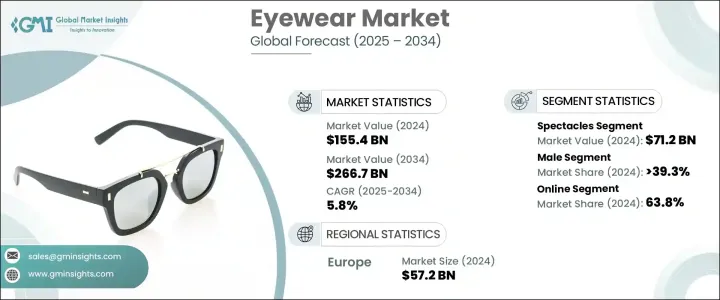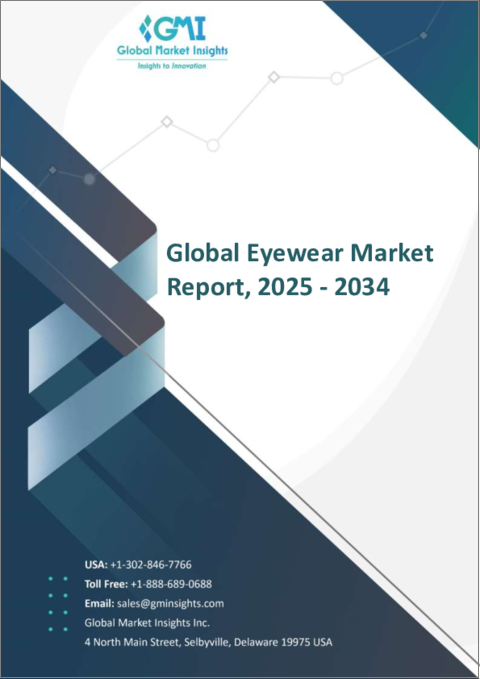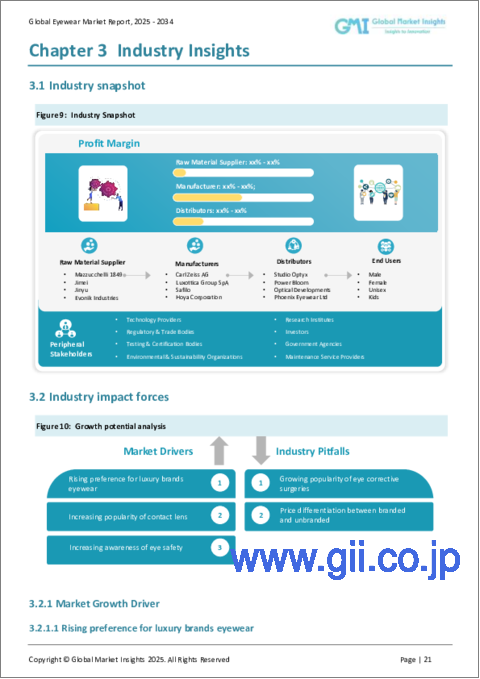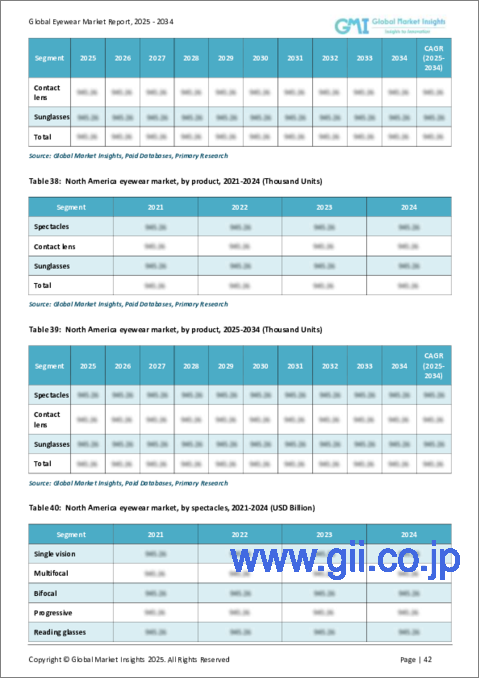|
|
市場調査レポート
商品コード
1721603
眼鏡市場の市場機会、成長促進要因、産業動向分析、2025年~2034年予測Eyewear Market Opportunity, Growth Drivers, Industry Trend Analysis, and Forecast 2025 - 2034 |
||||||
カスタマイズ可能
|
|||||||
| 眼鏡市場の市場機会、成長促進要因、産業動向分析、2025年~2034年予測 |
|
出版日: 2025年04月11日
発行: Global Market Insights Inc.
ページ情報: 英文 190 Pages
納期: 2~3営業日
|
全表示
- 概要
- 目次
眼鏡の世界市場は、2024年には1,554億米ドルとなり、CAGR 5.8%で成長し、2034年には2,667億米ドルに達すると予測されています。
この成長を促進している主な要因の一つは、ステータスを高めるアクセサリーとしての眼鏡の魅力の高まりです。今日の消費者は、メガネやサングラスを単なる視力補助具としてではなく、むしろ高級なライフスタイル製品として捉えています。ハイエンドの眼鏡へのシフトは、人々が自分のスタイルにマッチし、耐久性があり、特定の社会的アイデンティティを反映するデザインを求めるようになり、強い勢いを生み出しています。この動向は特に、高度な素材を使用し、高度なレンズ技術を駆使して作られた高級品を好むバイヤーの間で顕著です。このような嗜好は、機能とファッションを融合させた製品に対する需要を牽引しています。その上、セレブリティの影響力やブランドとの提携が、ラグジュアリーな眼鏡の魅力を増幅させ、あらゆる層の消費者の共感を呼ぶ独占感を生み出すのに役立っています。限定版の発売やデザイナーとのコラボレーションは、興奮と購入への切迫感を生み出し、この市場をさらに盛り上げています。その結果、この市場は、視力矯正だけでなく、個人のイメージ、快適さ、ブランド体験によって価値が定義されるような変化を経験しています。

製品セグメントにはメガネ、コンタクトレンズ、サングラスが含まれます。2024年には、メガネカテゴリーが712億米ドルの収益で市場をリードし、市場推計・予測期間中のCAGRは5.3%と予測されています。この成長の主な要因の1つは、一般にコンピュータ視覚症候群(CVS)として知られるデジタル眼精疲労の蔓延です。特にスマートフォン、コンピューター、タブレットを長時間使用することで、あらゆる年齢層でスクリーン使用時間が増加するため、まぶしさや疲労を軽減するように設計されたメガネを使用する人が増えています。パンデミックは、特に若いユーザーの間で遠隔学習やオンライン活動が急増したため、この動向を加速させました。アンチグレアや抗疲労コーティングが施された保護用眼鏡の人気が高まり、こうした製品の採用が増加しています。さらに、保護とファッションの両方に役立つ透明レンズや着色レンズのメガネへの動向も目立ち、市場の需要をさらに押し上げています。
| 市場範囲 | |
|---|---|
| 開始年 | 2024 |
| 予測年 | 2025-2034 |
| 開始金額 | 1,554億米ドル |
| 予測金額 | 2,667億米ドル |
| CAGR | 5.8% |
エンドユーザーの観点から、眼鏡市場は男性、女性、ユニセックス、キッズの各セグメントに分けられます。2024年には、男性層が市場全体の39.3%以上を占め、優位を占める。この層は2034年までCAGR 5.4%で成長すると予想されます。近視や老眼のような視力問題の有病率の高さ、プレミアムグレードの製品への関心の高さなど、男性消費者の旺盛な需要にはいくつかの要因が寄与しています。男性は、高度な機能性と洗練されたスタイルの両方を提供する眼鏡にますます傾倒しています。流行に左右されることなく、丈夫で長持ちするものを好む傾向が、多くのブランドの商品ポートフォリオを形成しています。さらに、スマートな眼鏡を含む、技術的に強化された製品への関心の高まりが、新たな機会を開いています。業務用であれ個人用であれ、性能、保護、洗練された美しさを兼ね備えた眼鏡は、このセグメントの共感を呼んでいます。
市場はまた、流通チャネル別にオンラインとオフラインのプラットフォームに区分されます。2024年には、オンライン販売が世界市場シェアの63.8%を占めると予測されています。eコマースの利便性は、スマートフォンの普及やデジタル・インターフェイスの向上と相まって、消費者の買い物方法を再定義しています。ブラウジングからバーチャル試着まで、シームレスなオンライン・ショッピング体験は、消費者が自宅にいながらにして十分な情報に基づいた選択ができるようにしました。詳細な商品レビュー、おすすめ商品、カスタマイズ・オプションが利用できることも、魅力に拍車をかけています。さらに、デジタル・プラットフォームは、ブランドが様々な購買層向けに商品を調整するのに役立ち、より包括的で効率的な体験を提供しています。眼鏡ブランドと大手オンライン小売業者とのコラボレーションも、市場への浸透と認知度を高めています。オンライン流通のスピードとリーチは、消費者の主要な選択肢となり、この動向は今後数年でさらに牽引力を増すと予想されます。
地域別では、欧州が2024年の世界の眼鏡市場をリードし、約572億米ドルの売上を計上、市場全体の約36.8%を占めました。この地域の優位性は、高級ファッションの伝統が深く根付いていること、有名眼鏡メーカーが存在感を示していること、高齢化社会で視力矯正のニーズが高まっていることなど、いくつかの要因によるものです。欧州の高級眼鏡におけるリーダーシップは、高度なレンズ技術と熟練した職人技によって強化されています。この地域は世界のデザイン基準を設定し続けており、イノベーションとハイエンドの魅力の両方の拠点となっています。
眼鏡業界の主要企業には、HOYA Corporation、Carl Zeiss AG、Rodenstock GmbH、Luxottica Group SpA、Safilo Group、Marchon眼鏡Inc.、De Rigo Vision S.p.A、Johnson &Johnson Vision Care Inc.、The Cooper Companiesなどがあります。これらの企業は、レンズイノベーション、プレミアムフレームデザイン、パーソナライズされたソリューションの最前線にいます。審美性、品質、光学性能を組み合わせる彼らの努力は、競合情勢を形成し続け、世界中の消費者の期待を高めています。
目次
第1章 調査手法と範囲
第2章 エグゼクティブサマリー
第3章 業界考察
- エコシステム分析
- サプライヤーの情勢
- 価格分析
- テクノロジーとイノベーションの情勢
- 主なニュースと取り組み
- 規制情勢
- 製造業者
- 販売代理店
- 小売業者
- 影響要因
- 促進要因
- 高級ブランドへの嗜好の高まり眼鏡
- コンタクトレンズの人気が高まる
- 目の安全に対する意識の向上
- 業界の潜在的リスク&課題
- 眼科矯正手術の人気が高まっている
- ブランド品と非ブランド品の価格差
- 促進要因
- 成長可能性分析
- 消費者行動分析
- 人口動向
- 購入決定に影響を与える要因
- 製品の好み
- 希望価格帯
- 優先流通チャネル
- ポーターの分析
- PESTEL分析
第4章 競合情勢
- イントロダクション
- 企業の市場シェア分析
- 競合ポジショニングマトリックス
- 戦略的展望マトリックス
第5章 市場推計・予測:製品別、2021-2034
- 主要動向
- 眼鏡
- 単焦点
- 多焦点
- 二重焦点
- プログレッシブ
- 老眼鏡
- 安全メガネ
- その他(ブルーライトグラスなど)
- コンタクトレンズ
- ソフトコンタクトレンズ
- ハードコンタクトレンズ
- その他(乱視用コンタクトレンズ)
- サングラス
- 偏光
- 非偏光
第6章 市場推計・予測:タイプ別、2021-2034
- 主要動向
- 処方箋
- 処方箋なし
第7章 市場推計・予測:フレーム素材別、2021-2034
- 主要動向
- 金属
- プラスチック
- ポリカーボネート
- ゴム
- その他(木製、ナイロン製など)
第8章 市場推計・予測:形状別、2021-2034
- 主要動向
- オーバル&アビエーター
- 長方形
- ラウンド
- 四角
- その他(特大、シールドなど)
第9章 市場推計・予測:価格別、2021-2034
- 主要動向
- 低
- 中
- 高
第10章 市場推計・予測:最終用途別、2021-2034
- 主要動向
- 男性
- 女性
- ユニセックス
- 子供
第11章 市場推計・予測:流通チャネル別、2021-2034
- 主要動向
- オンライン
- eコマース
- 企業サイト
- オフライン
- 専門店
- 大型小売店
- その他(眼鏡キャンプ、眼科センターなど)
第12章 市場推計・予測:地域別、2021-2034
- 主要動向
- 北米
- 米国
- カナダ
- 欧州
- 英国
- ドイツ
- フランス
- イタリア
- スペイン
- ロシア
- アジア太平洋地域
- 中国
- インド
- 日本
- オーストラリア
- 韓国
- ラテンアメリカ
- ブラジル
- メキシコ
- アルゼンチン
- マメア
- アラブ首長国連邦
- 南アフリカ
- サウジアラビア
第13章 企業プロファイル
- Carl Zeiss AG
- Luxottica Group SpA
- Safilo
- Hoya Corporation
- The Cooper Companies
- Johnson &Johnson Vision Care、Inc.
- Bausch &Lomb Inc.
- Charmant Group
- CIBA VISION
- De Rigo Vision S.p.A
- Fielmann AG
- JINS、Inc.
- Marchon Eyewear、Inc.
- QSpex Technologies
- Rodenstock GmbH
The Global Eyewear Market was valued at USD 155.4 billion in 2024 and is estimated to grow at a CAGR of 5.8% to reach USD 266.7 billion by 2034. One of the key factors fueling this growth is the rising appeal of eyewear as a status-enhancing accessory. Consumers today no longer view eyeglasses and sunglasses as mere vision aids but rather as premium lifestyle products. The shift toward high-end eyewear is creating strong momentum as people look for designs that match their personal style, offer durability, and reflect a certain social identity. This trend is particularly strong among buyers who prefer exclusive, well-crafted pieces made from advanced materials and featuring enhanced lens technologies. These preferences are driving demand for products that blend function and fashion. On top of that, celebrity influence and brand partnerships are amplifying the appeal of luxury eyewear, helping create a sense of exclusivity that resonates with consumers across demographics. Limited-edition releases and designer collaborations further enhance this market by generating excitement and urgency to purchase. As a result, the market is experiencing a transformation where value is defined not only by vision correction but also by personal image, comfort, and brand experience.

The product segment includes spectacles, contact lenses, and sunglasses. In 2024, the spectacles category led the market with revenue of USD 71.2 billion and is estimated to register a CAGR of 5.3% during the forecast period. One major contributor to this growth is the widespread incidence of digital eye strain, commonly known as computer vision syndrome (CVS). As screen time increases across all age groups, especially with prolonged exposure to smartphones, computers, and tablets, more individuals are turning to glasses designed to reduce glare and fatigue. The pandemic accelerated this trend as remote learning and online activities spiked, especially among younger users. The growing popularity of protective eyewear equipped with anti-glare and anti-fatigue coatings has led to increased adoption of such products. Additionally, there is a visible trend toward clear and tinted lens glasses that serve both protective and fashion purposes, further boosting market demand.
| Market Scope | |
|---|---|
| Start Year | 2024 |
| Forecast Year | 2025-2034 |
| Start Value | $155.4 Billion |
| Forecast Value | $266.7 Billion |
| CAGR | 5.8% |
From the end-user perspective, the eyewear market is divided into male, female, unisex, and kids segments. In 2024, the male demographic dominated the landscape, holding more than 39.3% of the total market share. This group is expected to grow at a CAGR of 5.4% through 2034. Several factors are contributing to the strong demand from male consumers, including a higher prevalence of vision issues like myopia and presbyopia, as well as greater interest in premium-grade products. Men are increasingly leaning toward eyewear that offers both advanced functionality and refined style. Their preference for durable, long-lasting items over trend-based purchases is shaping the product portfolios of many brands. Additionally, growing interest in technologically enhanced products, including smart eyewear, is opening new opportunities. Whether for professional settings or personal use, eyewear that combines performance, protection, and polished aesthetics is resonating with this segment.
The market is also segmented by distribution channel into online and offline platforms. In 2024, online sales are projected to account for 63.8% of the global market share. The convenience of e-commerce, paired with increasing smartphone penetration and better digital interfaces, has redefined how consumers shop for eyewear. A seamless online shopping experience - from browsing to virtual try-ons - has empowered consumers to make informed choices from the comfort of their homes. The availability of detailed product reviews, recommendations, and customization options adds to the appeal. Moreover, digital platforms help brands tailor offerings for various buyer groups, making the experience more inclusive and efficient. Collaborations between eyewear brands and major online retailers have also enhanced market penetration and visibility. The speed and reach of online distribution have turned it into the primary choice for consumers, and this trend is expected to gain further traction over the coming years.
Geographically, Europe led the global eyewear market in 2024, contributing approximately USD 57.2 billion in revenue and accounting for around 36.8% of the overall market. The region's dominance is attributed to several factors, including its deep-rooted heritage in luxury fashion, a robust presence of renowned optical manufacturers, and a growing need for vision correction in an aging population. Europe's leadership in premium eyewear is reinforced by its advanced lens technologies and skilled craftsmanship. The region continues to set global design standards, making it a stronghold for both innovation and high-end appeal.
Leading players in the eyewear industry include Hoya Corporation, Carl Zeiss AG, Rodenstock GmbH, Luxottica Group SpA, Safilo Group, Marchon Eyewear Inc., De Rigo Vision S.p.A, Johnson & Johnson Vision Care Inc., and The Cooper Companies. These companies are at the forefront of lens innovation, premium frame design, and personalized solutions. Their efforts to combine aesthetics, quality, and optical performance continue to shape the competitive landscape and elevate consumer expectations worldwide.
Table of Contents
Chapter 1 Methodology & Scope
- 1.1 Research design
- 1.1.1 Research approach
- 1.1.2 Data collection methods
- 1.2 Base estimates and calculations
- 1.2.1 Base year calculation
- 1.2.2 Key trends for market estimates
- 1.3 Forecast model
- 1.4 Primary research & validation
- 1.4.1 Primary sources
- 1.4.2 Data mining sources
- 1.5 Market definitions
Chapter 2 Executive Summary
- 2.1 Industry synopsis, 2021 - 2034
Chapter 3 Industry Insights
- 3.1 Industry ecosystem analysis
- 3.2 Supplier landscape
- 3.3 Pricing analysis
- 3.4 Technology & innovation landscape
- 3.5 Key news & initiatives
- 3.6 Regulatory landscape
- 3.7 Manufacturers
- 3.8 Distributors
- 3.9 Retailers
- 3.10 Impact on forces
- 3.10.1 Growth drivers
- 3.10.1.1 Rising preference for luxury brands eyewear
- 3.10.1.2 Increasing popularity of contact lens
- 3.10.1.3 Increasing awareness of eye safety
- 3.10.2 Industry pitfalls & challenges
- 3.10.2.1 Growing popularity of eye corrective surgeries
- 3.10.2.2 Price differentiation between branded and unbranded
- 3.10.1 Growth drivers
- 3.11 Growth potential analysis
- 3.12 Consumer behavior analysis
- 3.12.1 Demographic trends
- 3.12.2 Factors affecting buying decisions
- 3.12.3 Product Preference
- 3.12.4 Preferred price range
- 3.12.5 Preferred distribution channel
- 3.13 Porter’s analysis
- 3.14 PESTEL analysis
Chapter 4 Competitive Landscape, 2024
- 4.1 Introduction
- 4.2 Company market share analysis
- 4.3 Competitive positioning matrix
- 4.4 Strategic outlook matrix
Chapter 5 Market Estimates & Forecast, By Product, 2021 - 2034 ($Bn) (Thousand Units)
- 5.1 Key trends
- 5.2 Spectacles
- 5.2.1 Single vision
- 5.2.2 Multifocal
- 5.2.3 Bifocal
- 5.2.4 Progressive
- 5.2.5 Reading glasses
- 5.2.6 Safety glasses
- 5.2.7 Others (blue light glasses, etc.)
- 5.3 Contact lens
- 5.3.1 Soft contact lens
- 5.3.2 Rigid contact lens
- 5.3.3 Others (toric contact lens)
- 5.4 Sunglasses
- 5.4.1 Polarized
- 5.4.2 Non-polarized
Chapter 6 Market Estimates & Forecast, By Type, 2021 - 2034 ($Bn) (Thousand Units)
- 6.1 Key trends
- 6.2 Prescription
- 6.3 Non-prescription
Chapter 7 Market Estimates & Forecast, By Frame Material, 2021 - 2034 ($Bn) (Thousand Units)
- 7.1 Key trends
- 7.2 Metal
- 7.3 Plastic
- 7.4 Polycarbonate
- 7.5 Rubbers
- 7.6 Others (wooden, nylon, etc.)
Chapter 8 Market Estimates & Forecast, By Shape, 2021 - 2034 ($Bn) (Thousand Units)
- 8.1 Key trends
- 8.2 Oval & aviator
- 8.3 Rectangular
- 8.4 Round
- 8.5 Square
- 8.6 Others (oversized, shield, etc.)
Chapter 9 Market Estimates & Forecast, By Price, 2021 - 2034 ($Bn) (Thousand Units)
- 9.1 Key trends
- 9.2 Low
- 9.3 Medium
- 9.4 High
Chapter 10 Market Estimates & Forecast, By End Use, 2021 - 2034 ($Bn) (Thousand Units)
- 10.1 Key trends
- 10.2 Male
- 10.3 Female
- 10.4 Unisex
- 10.5 Kids
Chapter 11 Market Estimates & Forecast, By Distribution Channel, 2021 - 2034 ($Bn) (Thousand Units)
- 11.1 Key trends
- 11.2 Online
- 11.2.1 E-commerce
- 11.2.2 Company site
- 11.3 Offline
- 11.3.1 Specialty stores
- 11.3.2 Mega retail stores
- 11.3.3 Others (optical camps, ophthalmic centers, etc.)
Chapter 12 Market Estimates & Forecast, By Region, 2021 - 2034 ($Bn) (Thousand Units)
- 12.1 Key trends
- 12.2 North America
- 12.2.1 U.S.
- 12.2.2 Canada
- 12.3 Europe
- 12.3.1 UK
- 12.3.2 Germany
- 12.3.3 France
- 12.3.4 Italy
- 12.3.5 Spain
- 12.3.6 Russia
- 12.4 Asia Pacific
- 12.4.1 China
- 12.4.2 India
- 12.4.3 Japan
- 12.4.4 Australia
- 12.4.5 South Korea
- 12.5 Latin America
- 12.5.1 Brazil
- 12.5.2 Mexico
- 12.5.3 Argentina
- 12.6 MAMEA
- 12.6.1 UAE
- 12.6.2 South Africa
- 12.6.3 Saudi Arabia
Chapter 13 Company Profiles
- 13.1 Carl Zeiss AG
- 13.2 Luxottica Group SpA
- 13.3 Safilo
- 13.4 Hoya Corporation
- 13.5 The Cooper Companies
- 13.6 Johnson & Johnson Vision Care, Inc.
- 13.7 Bausch & Lomb Inc.
- 13.8 Charmant Group
- 13.9 CIBA VISION
- 13.10 De Rigo Vision S.p.A
- 13.11 Fielmann AG
- 13.12 JINS, Inc.
- 13.13 Marchon Eyewear, Inc.
- 13.14 QSpex Technologies
- 13.15 Rodenstock GmbH





